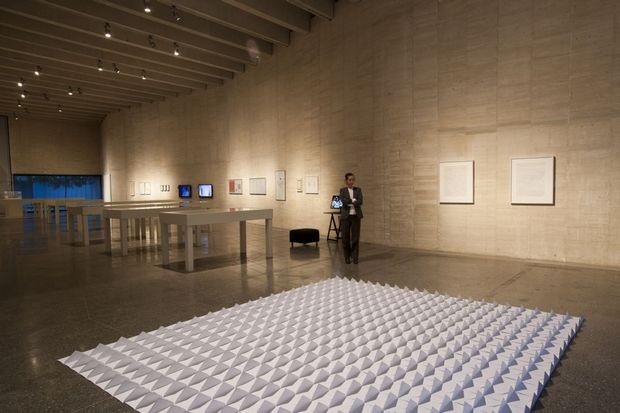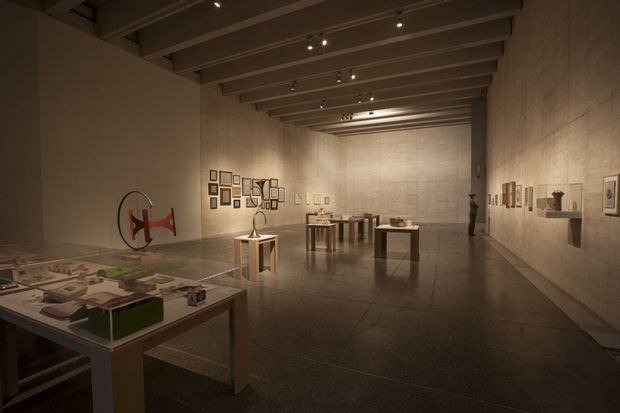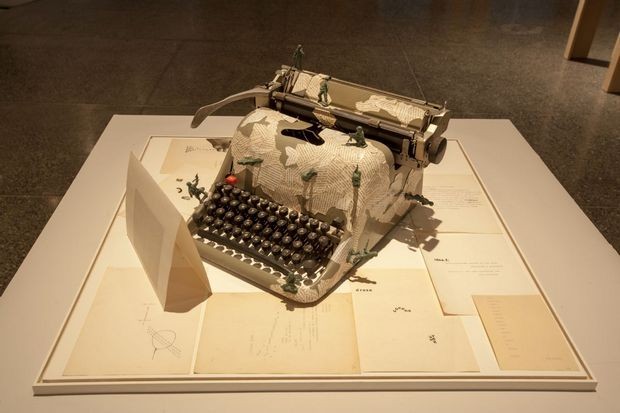CONSTELLATIONS. Experimental Poetry in Spain (1963-2016)
Varios Autores
21 Jan - 04 Jun 2017
CONSTELLATIONS. EXPERIMENTAL POETRY IN SPAIN (1963-2016)
Varios Autores
Halls 4 and 5
21 January - 4 June 2017
Curatorship: Luis Marigómez, Esperanza Ortega, José Luis Puerto, Tomás Sánchez Santiago
Coordination: Carlos Ordás
Artists: Juan Carlos Aberasturi, Justo Alejo, Francisco Aliseda, Julián Alonso, Nel Amaro, Gregorio Antolín, Archipiel (Álvaro Barriuso y Ainara LeGardon), Alain Arias-Misson, Elena Asins, Max Aub, Eugènia Balcells, Eduardo Barbero, Pablo del Barco, J. M. Barrado, José María Benéitez, Raimon Blu, Felipe Boso, Antonio Bouza, Joan Brossa, Pepe Cáccamo, J. L. Calleja, José Luis Campal, Julio Campal, Cuca Canals, Carles Cano, Dionisio Cañas, José Luis Castillejo, Domingo Ceborro, Juan Eduardo Cirlot, Corpá, Rafael de Cózar, Juan Crego, Francisco Felipe Figueroa, Luis Ángel Fernández García, Jesús Fernández Palacios, Bartolomé Ferrando, Estanis Ferrer, Esther Ferrer, Flatus Vocis Trio, Carles Hac Mor, García de Marina, Antonio Gómez, Ignacio Gómez De Liaño, Goval (José Antonio Gómez Valera), Juan Hidalgo, Eva Hiernaux, Ibírico, José María Iglesias, Pascual Izquierdo Abad, Jesús Ge, Juan López de Ael, Clara López Cantos, Alfonso López Gradolí, Lola López-Cózar, Rafael Marín, Miquel Martí i Pol, Juan Carlos Mestre, Fernando Millán, Fátima Miranda, Enric Miralles, Antonio Monterroso, Antonio Montesino, Ma Jesús Montía, José Noriega, Antonio Orihuela, Jorge Oteiza, José María Parreño, Saray Pavón Márquez, Carmen Peralto, Francisco Peralto, Francisco Pino, Benito del Pliego, Claudia Quade Frau, Sergi Quiñonero, César Reglero, Tomás Salvador González, María Sánchez, Néstor Sanmiguel Diest, Eduardo Scala, J. Seafree, Patxi Serrano, Colectivo Stidna, Los Torreznos (Rafael Lamata y Jaime Vallaure), José-Miguel Ullán, Isidoro Valcárcel Medina, Adolfo Vargas, Eva Ma Vaz, Gustavo Vega, Guillem Viladot, Yang-Tae Min, Fernando Zamora.
With Constellations. Experimental Poetry in Spain (1963-2016), MUSAC addresses for the first time the presence and impact of visual and experimental poetry in Spain from the 1960s up to the present day. The exhibition aims to give an account of a number of areas that, since the beginning of their poetic practice, attracted certain authors who distanced themselves from the conventional expectations and created a fascinating cosmos—impossible to define and capture easily or to be restrained in its expansive vitality—which rejects one way roads.
As we know, the modern root of this attitude lies in the historical avant-gardes of the 20th century, when the space of the poem was assaulted with (in)formal procedures that proposed an overstepping of the boundaries of poetic discourse in a process of radical deconstruction maintained up to now in creative mechanisms. After II World War, the area of representation of the poem expands in an exercise of freedom of expression ranging from the sovereignty of the most fragile to the complexity involved in having new reproduction media to increase the reach of the poetic sign, which freed itself even more of the verbal obsession until it was considered an art object.
And it is precisely this overflowing in multiple directions what the structure of Constellations seeks to stress. Departing from thematic lines that remain in force in the 21st century—the supremacy of the letter as energy-bearing unit, the intervention of the poem in public languages or the constant presence of the deck as a symbol of games and randomness, among others—, the show presents a review of the evolution of various discursive procedures of visual and experimental poetry in Spain.
We enter the body of the exhibition through ABISMOS [Abysses], which sheds light on this progressive stripping that starts with the reclaiming of the letter as the resilient unit of verbal supremacy, able to contain in itself the expressive power of the language, and ending with different phonetic pieces where language is Dadaistically bare to the bones. Between these two poles, other pieces gradually belie the value of writing as a meaning carrier by means of calligraphic works—from the calligram with an age-old tradition to different styles of cryptography—or discourse denials—, “manchas nombradas” [named stains] as José-Miguel Ullán put it—in a succession that openly suggests an estrangement from verbality and meaning.
After ABISMOS, the core part called SAQUEOS [Looting] highlights the improper intervention of the poets in the languages of the social sphere—written press, ordinary post — as well as the subversion of canonical and stagnant models of traditional poetry, exemplified here in the sonnet. The current validity of collage poems, mail art or the acceptance of the deck of cards as symbolic material—one on which the poets continue to act with unlimited boldness—is shown in SAQUEOS, underpinned with creative procedures that range from the purely handcrafted to the use of today"s virtual tools.
After the intermediate step represented by HOMENAJES [Tributes], with which the authors seek to found their own tradition by dedicating their pieces to landmark poets—such as Schwitters, Brossa, Pino—or establishing bridges with certain poets of discursive weight, Constellations enters fully into the world of visual poetry, when the image is the prominent, and sometimes exclusive, component of the poem. Here the visitor will find visual proposals that flow naturally into the following section, EXTRAÑAMIENTOS [Estrangements], devoted to the sovereignty of the object as an absolute language imposing its volume, its materiality, and, therefore, the definitive intrusion of things in the world of words. The validity of the container—sometimes things rescued from the commercial circuit such as a box or a can—as a substitute for the book also certifies in this section the loss of aura experienced by the printed page in poetic communication. That is why, with “Esto sí es una revista” [This is indeed a magazine]—a nod to Magritte—the show goes on to present a significant sample of the so-called assembling magazines, which, in unexpected ways, exceed the scope of the concept of a literary magazine, otherwise taken for granted in the strictly literary world.
The final stretch of the exhibition proposes a natural sequence of samples where we can see from the first attempts at disrupting the verbal speech by means of drillings and perforations—with authors such as Pino or Justo Alejo—to current poets—Pepe Cáccamo, Fernando Zamora and Claudia Quade among others names—that maintain that assertion of the speech through a search of the void beyond, of the ultimate inside of the nominal substance of words.
A sample of videos of performances and video poems, that have previously been placed at specific locations through the itinerary of Constellations, awaits the visitor at this point to confront him again with the schematic and cardinal power of poetic language, before reaching another suggestive installation by Bartolomé Ferrando, Silencio [Silence], that marks the end of this panoramic exhibition.
Lenders
Julián Alonso
Archivo Lafuente
Ayuntamiento de Burgos
Biblioteca Altaió
CCCB
Centro de Poesía Visual Peñarroya
Victoria Cirlot
Diputación de Badajoz
Luis Ángel Fernández García
El Gato Gris Edicione
Enrique Granell
Josep Miquel García
Antonio Gómez
Fundació Guillem Viladot
Freijo Gallery, Madrid
Fundación Instituto Castellano y Leonés de la Lengua
Fundación Jorge Guillén
Fundación Museo Jorge Oteiza
Galería Carles Taché
Generalitat Valenciana
Alberto Martínez
Instituto Leonés de Cultura
Begoña Múñez González y José García Alonso
Museo Nacional Centro de Arte Reina Sofía, Madrid
Museu Nacional d’Art de Catalunya
Esperanza Ortega
Begoña Pérez Rivera
José Luis Puerto
Tomás Sánchez Santiago
Varios Autores
Halls 4 and 5
21 January - 4 June 2017
Curatorship: Luis Marigómez, Esperanza Ortega, José Luis Puerto, Tomás Sánchez Santiago
Coordination: Carlos Ordás
Artists: Juan Carlos Aberasturi, Justo Alejo, Francisco Aliseda, Julián Alonso, Nel Amaro, Gregorio Antolín, Archipiel (Álvaro Barriuso y Ainara LeGardon), Alain Arias-Misson, Elena Asins, Max Aub, Eugènia Balcells, Eduardo Barbero, Pablo del Barco, J. M. Barrado, José María Benéitez, Raimon Blu, Felipe Boso, Antonio Bouza, Joan Brossa, Pepe Cáccamo, J. L. Calleja, José Luis Campal, Julio Campal, Cuca Canals, Carles Cano, Dionisio Cañas, José Luis Castillejo, Domingo Ceborro, Juan Eduardo Cirlot, Corpá, Rafael de Cózar, Juan Crego, Francisco Felipe Figueroa, Luis Ángel Fernández García, Jesús Fernández Palacios, Bartolomé Ferrando, Estanis Ferrer, Esther Ferrer, Flatus Vocis Trio, Carles Hac Mor, García de Marina, Antonio Gómez, Ignacio Gómez De Liaño, Goval (José Antonio Gómez Valera), Juan Hidalgo, Eva Hiernaux, Ibírico, José María Iglesias, Pascual Izquierdo Abad, Jesús Ge, Juan López de Ael, Clara López Cantos, Alfonso López Gradolí, Lola López-Cózar, Rafael Marín, Miquel Martí i Pol, Juan Carlos Mestre, Fernando Millán, Fátima Miranda, Enric Miralles, Antonio Monterroso, Antonio Montesino, Ma Jesús Montía, José Noriega, Antonio Orihuela, Jorge Oteiza, José María Parreño, Saray Pavón Márquez, Carmen Peralto, Francisco Peralto, Francisco Pino, Benito del Pliego, Claudia Quade Frau, Sergi Quiñonero, César Reglero, Tomás Salvador González, María Sánchez, Néstor Sanmiguel Diest, Eduardo Scala, J. Seafree, Patxi Serrano, Colectivo Stidna, Los Torreznos (Rafael Lamata y Jaime Vallaure), José-Miguel Ullán, Isidoro Valcárcel Medina, Adolfo Vargas, Eva Ma Vaz, Gustavo Vega, Guillem Viladot, Yang-Tae Min, Fernando Zamora.
With Constellations. Experimental Poetry in Spain (1963-2016), MUSAC addresses for the first time the presence and impact of visual and experimental poetry in Spain from the 1960s up to the present day. The exhibition aims to give an account of a number of areas that, since the beginning of their poetic practice, attracted certain authors who distanced themselves from the conventional expectations and created a fascinating cosmos—impossible to define and capture easily or to be restrained in its expansive vitality—which rejects one way roads.
As we know, the modern root of this attitude lies in the historical avant-gardes of the 20th century, when the space of the poem was assaulted with (in)formal procedures that proposed an overstepping of the boundaries of poetic discourse in a process of radical deconstruction maintained up to now in creative mechanisms. After II World War, the area of representation of the poem expands in an exercise of freedom of expression ranging from the sovereignty of the most fragile to the complexity involved in having new reproduction media to increase the reach of the poetic sign, which freed itself even more of the verbal obsession until it was considered an art object.
And it is precisely this overflowing in multiple directions what the structure of Constellations seeks to stress. Departing from thematic lines that remain in force in the 21st century—the supremacy of the letter as energy-bearing unit, the intervention of the poem in public languages or the constant presence of the deck as a symbol of games and randomness, among others—, the show presents a review of the evolution of various discursive procedures of visual and experimental poetry in Spain.
We enter the body of the exhibition through ABISMOS [Abysses], which sheds light on this progressive stripping that starts with the reclaiming of the letter as the resilient unit of verbal supremacy, able to contain in itself the expressive power of the language, and ending with different phonetic pieces where language is Dadaistically bare to the bones. Between these two poles, other pieces gradually belie the value of writing as a meaning carrier by means of calligraphic works—from the calligram with an age-old tradition to different styles of cryptography—or discourse denials—, “manchas nombradas” [named stains] as José-Miguel Ullán put it—in a succession that openly suggests an estrangement from verbality and meaning.
After ABISMOS, the core part called SAQUEOS [Looting] highlights the improper intervention of the poets in the languages of the social sphere—written press, ordinary post — as well as the subversion of canonical and stagnant models of traditional poetry, exemplified here in the sonnet. The current validity of collage poems, mail art or the acceptance of the deck of cards as symbolic material—one on which the poets continue to act with unlimited boldness—is shown in SAQUEOS, underpinned with creative procedures that range from the purely handcrafted to the use of today"s virtual tools.
After the intermediate step represented by HOMENAJES [Tributes], with which the authors seek to found their own tradition by dedicating their pieces to landmark poets—such as Schwitters, Brossa, Pino—or establishing bridges with certain poets of discursive weight, Constellations enters fully into the world of visual poetry, when the image is the prominent, and sometimes exclusive, component of the poem. Here the visitor will find visual proposals that flow naturally into the following section, EXTRAÑAMIENTOS [Estrangements], devoted to the sovereignty of the object as an absolute language imposing its volume, its materiality, and, therefore, the definitive intrusion of things in the world of words. The validity of the container—sometimes things rescued from the commercial circuit such as a box or a can—as a substitute for the book also certifies in this section the loss of aura experienced by the printed page in poetic communication. That is why, with “Esto sí es una revista” [This is indeed a magazine]—a nod to Magritte—the show goes on to present a significant sample of the so-called assembling magazines, which, in unexpected ways, exceed the scope of the concept of a literary magazine, otherwise taken for granted in the strictly literary world.
The final stretch of the exhibition proposes a natural sequence of samples where we can see from the first attempts at disrupting the verbal speech by means of drillings and perforations—with authors such as Pino or Justo Alejo—to current poets—Pepe Cáccamo, Fernando Zamora and Claudia Quade among others names—that maintain that assertion of the speech through a search of the void beyond, of the ultimate inside of the nominal substance of words.
A sample of videos of performances and video poems, that have previously been placed at specific locations through the itinerary of Constellations, awaits the visitor at this point to confront him again with the schematic and cardinal power of poetic language, before reaching another suggestive installation by Bartolomé Ferrando, Silencio [Silence], that marks the end of this panoramic exhibition.
Lenders
Julián Alonso
Archivo Lafuente
Ayuntamiento de Burgos
Biblioteca Altaió
CCCB
Centro de Poesía Visual Peñarroya
Victoria Cirlot
Diputación de Badajoz
Luis Ángel Fernández García
El Gato Gris Edicione
Enrique Granell
Josep Miquel García
Antonio Gómez
Fundació Guillem Viladot
Freijo Gallery, Madrid
Fundación Instituto Castellano y Leonés de la Lengua
Fundación Jorge Guillén
Fundación Museo Jorge Oteiza
Galería Carles Taché
Generalitat Valenciana
Alberto Martínez
Instituto Leonés de Cultura
Begoña Múñez González y José García Alonso
Museo Nacional Centro de Arte Reina Sofía, Madrid
Museu Nacional d’Art de Catalunya
Esperanza Ortega
Begoña Pérez Rivera
José Luis Puerto
Tomás Sánchez Santiago





